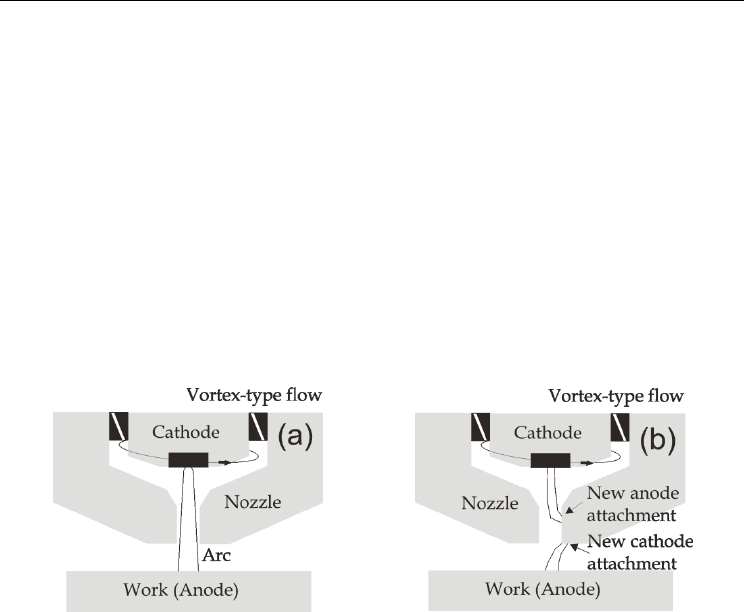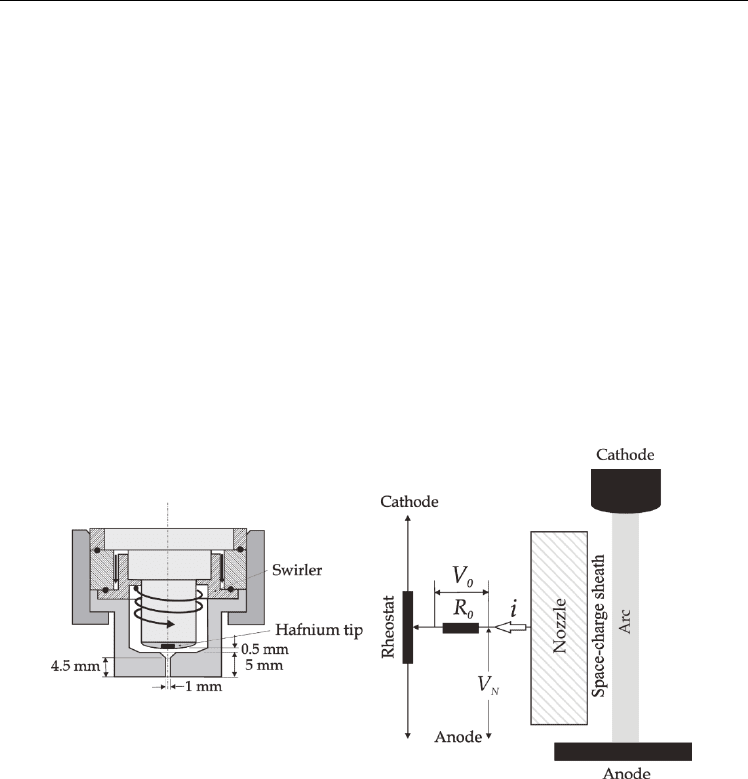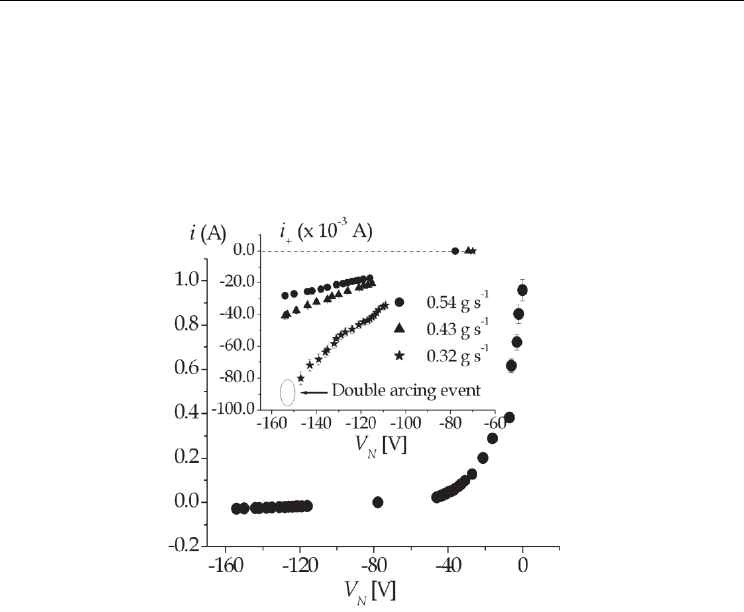Awrejcewicz J. Numerical Simulations of Physical and Engineering Processes
Подождите немного. Документ загружается.

23
On the Double-Arcing Phenomenon
in a Cutting Arc Torch
Leandro Prevosto
1
, Héctor Kelly
1,2
and Beatriz Mancinelli
1
1
Grupo de Descargas Eléctricas, Departamento Ing. Electromecánica, Facultad Regional
Venado Tuerto (UTN), Laprida 651, Venado Tuerto (2600), Santa Fe
2
Instituto de Física del Plasma (CONICET), Departamento de Física, Facultad de Ciencias
Exactas y Naturales (UBA) Ciudad Universitaria Pab. I, (1428), Buenos Aires
Argentina
1. Introduction
Transferred arc plasma torches are widely used in industrial cutting process of metallic
materials because of their ability to cut almost any metal and the very high productivity that
can be achieved with this technology (Boulos et al., 1994).
The plasma cutting process is characterized by a transferred electric arc that is established
between a cathode, which is a part of the cutting torch, and a work-piece (the metal to be
cut) acting as the anode. In order to obtain a high-quality cut, the plasma jet must be as
collimated as possible and also must have a high power density. To this end, the transferred
arc is constricted by a metallic tube (a nozzle) with a small inner diameter (of the order of
one millimeter). Usually, a vortex-type flow with large axial and azimuthal velocity
components is forced through the nozzle to provide arc stability and to protect its inner
wall. In such case the hot arc is confined to the center of the nozzle, while centrifugal forces
drive the colder fluid towards the nozzle walls, which are thus thermally protected. The
axial component of the gas flow continuously supplies cold fluid, providing an intense
convective cooling at the arc fringes. In addition, the vortex flow enhances the power
dissipation per unit length of the arc column, resulting in high temperatures at the arc axis.
Since the nozzle is subjected to a very high heat flux, it is made of a metal with a high
thermal conductivity (copper is broadly used). The arc current is of the order of ten up to a
few hundred amperes, and the gas pressure is several atmospheres. Arc axis temperatures
around 15 kK are usual, but larger values, close to 25 kK or even higher, have been reached.
A typical configuration of a cutting torch is presented in Fig. 1(a).
The most explored region of plasma in an arc cutting system is the arc column located
between the nozzle exit and the work-piece. The experimental data from that region are
obtained usually by non-invasive spectroscopic techniques (Girard et at., 2006; Peters et al.,
2007; Freton et al., 2002, 2003; Pardo et al., 1999). Recently, also Langmuir probes have been
used for plasma diagnostics in this kind of arcs (Prevosto et al., 2008a, 2008b, 2009a).
However, due to the smallness of the nozzle bore, and the hostile conditions occurring
inside such arcs, access to experimental information about the plasma state inside the nozzle
region is out of reach to most plasma diagnostics; thus the published experimental data on
the arc column located between the cathode and the nozzle exit are very scarce (Prevosto et

Numerical Simulations of Physical and Engineering Processes
504
al., 2009b). Numerical simulations are usually used to study this region. However, most of
the developed numerical simulations are based on the plasma local thermodynamic
equilibrium (LTE) assumption (Freton et al., 2002, 2003; Gonzalez-Aguilar et al., 1999), in
spite of the fact that substantial deviations from LTE should occur at the arc boundary
inside the torch, where the electron density is presumably much lower than that prescribed
by the Griem´s criterion for LTE equilibrium (Boulos et al., 1994); and where very high
temperature gradients may be present over the last few electron Debye lengths from the
nozzle wall. Only recently, a non- local thermodynamic equilibrium (NLTE) modelling of a
200 A oxygen-plasma cutting torch was presented (Ghorui et al., 2007). In this work, it was
shown that the electron temperature remained high near the nozzle wall and hence well
decoupled from the heavy particle temperature. For instance, an electron temperature of
about 12000 K was reported for the arc boundary at the nozzle exit (a value much higher
than the heavy particle temperature of about 1000 K close to the inner nozzle wall
temperature).
The problem of sheath formation at the plasma boundary is of importance for nearly all
applications where the plasma is confined totally or partially to a finite volume by solid walls –
as in the case of cutting torch nozzles–(Riemann, 1991). When a plasma is in contact with a
negatively biased surface (with a biasing voltage of the order or lower than the floating value),
a strong electric field appears between the NLTE plasma and that surface. This sheath becomes
positively charged, rejecting electrons from the plasma and attracting ions to the negatively
biased wall. The typical thickness of the sheath as compared with the characteristic lengths of
the plasma (e.g., ion mean-free-path) determines the collisional degree of the sheath. Three
regimes of sheath behavior can appear in high pressure plasmas. There is a collision-
dominated (i.e., mobility limited) regime when the sheath thickness is larger than the ion mean
free path, a collisionless regime when the sheath is very thin, and a transition regime when
both lengths are comparable. For the collision-dominated regime, expressions that describe the
sheath have been developed for both the cases of constant ion mean-free-path, and constant
ion mobility (Franklin, 2002a; Riemann, 2003; Sheridan & Goeckner, 1995). In the opposite
limit, when ion collisions are negligible, Child’s law gives a simple description of the sheath
(Raizer, 1991). The number of ion mean-free-paths in the sheath needed to cause the transition
from the collisionless to the collision-dominated regime for the constant mean-free-path model
is only about one-half (Sheridan & Goree, 1991).
For high-pressure weakly ionized plasmas the sheath thickness is usually large compared
with the ion mean-free-path, and the sheath is collision-dominated. Such a picture
corresponds to the space-charge sheath formed between the NLTE plasma and the nozzle
wall inside of a cutting torch because, as it will be shown later, the electron temperature is
low. Near the plasma-sheath boundary the electric field accelerating the ions toward the
walls is negligible. Thus the fluid velocity of the ions is small as compared to their thermal
motion and the collision frequency is independent of the ion fluid velocity. On the other
hand, well inside the sheath region, the electric field accelerates the ions to velocities
comparable or larger than its thermal speed, and the collision frequency becomes
proportional to the ion drift velocity. There is a smooth transition from a constant collision
frequency of the ions within the plasma at the sheath edge to an approximately constant
mean-free-path of the ions at the sheath region close to the wall where a high electric field
exists. A smooth transition between these two ion collision approximations appears where
the potential drop over an ion mean-free-path becomes comparable to the ion thermal
energy (Sternovsky & Robertson, 2006).

On the Double-Arcing Phenomenon in a Cutting Arc Torch
505
In the normal mode of operation –Fig. 1(a)–, the nozzle is a floating conductor (i.e., it is not
electrically connected to any part of the torch electric circuit). However, such operating
mode is somewhat unstable. The much higher electrical conductivity of the nozzle as
compared with that of the confined arc column would cause instability. Under certain
operating conditions (too large arc current, too small gas mass flow, or a nozzle with a too
small bore diameter or with a too large length) the level of arc stabilization provided by the
vortex flow can be insufficient and the arc, which normally connects the cathode and the
work-piece, is broken into two. One of them connects the cathode with the nozzle and the
other connects the nozzle with the anode –see Fig. 1(b)–; following the path of smallest
electrical resistance. Such type of arc instability is called double-arcing. From a practical
point of view, the double-arcing is very undesirable; since the arc roots on the nozzle wall
(especially that corresponding to the arc originated from the cathode) usually destroy the
nozzle almost instantaneously (Nemchinsky & Severance, 2006). However, in a recent
review (Colombo et al, 2009); high-speed images of a “non-destructive” double-arcing with
a short duration (< 1 ms) were registered in cutting torches at low gas flow rates.
Fig. 1. Normal (a) and double-arcing (b) modes of nozzle operation of transferred arc cutting
torch.
The aim of this chapter is to presents a comprehensive study of the double-arcing
phenomenon which, as quoted above, is one of the main drawbacks that put limits to
increasing capabilities of the plasma arc cutting process. Surprisingly, relatively little has
been done to explore and understand this process, keeping in mind that the double-arcing is
common not only to arc cutting but to other industrial processes as well. Section 2 presents
some hypothesis suggested in the literature on the physical mechanism that triggers the
double-arcing in cutting torches. In Section 3, an experimental study carried out by the
authors is presented. The starting point for such a study is the analysis and interpretation of
the nozzle current-voltage characteristic curve. Since there is no comprehensive theory for
interpreting the electron branch in highly collisional plasmas, only the ion branch is
analyzed. The influence of the collisions on the physical structure of the plasma-nozzle
transition has been considered under the typical assumption of constant ion mean free path.
Within this assumption and using an approximate analytical solution for the sheath
thickness, the value of the ion flux to the wall is related to the nozzle voltage and the
electron temperature and density at the plasma boundary. To describe the plasma
composition an appropriate non-equilibrium two-temperature statistical model was used. A
physical interpretation on the origin of the double-arcing phenomenon is presented, that
explains why the double-arcing (that it is established when the space-charge sheath adjacent

Numerical Simulations of Physical and Engineering Processes
506
to the nozzle wall breaks-down) appears for example at low values of the gas mass flow. A
complementary numerical study of the space-charge sheath formed between the plasma and
the nozzle wall of a cutting torch is also reported in Section 4. The numerical study
corresponds to a collision-dominated model (ion mobility-limited motion) for the
hydrodynamic description of the sheath adjacent to the nozzle wall inside of a cutting torch.
The model does not assume cold ions so drift-diffusion type equations are used. Also an
improved expression for the ion-neutral momentum transfer is employed, instead of the
classical ion collision approximations (constant ion mean free path, and constant ion
collision frequency). The ion and electron densities, electrostatic potential and ion velocity
distributions are calculated inside the sheath. Boundary conditions for the numerical
solutions within this sheath are based on experimental plasma data previously obtained by
the authors. A physical explanation on the origin of the transient double-arcing (the so
called non-destructive double-arcing) in cutting torches is reported in Section 5. Against to
the proposed hypothesis (Colombo et al., 2009; Nemchinsky 2009) which assumes a
transient arc voltage rise due to dielectric films deposited on the nozzle surface (which are
later either carried away by the gas flow or are burned out); the experimental observations
suggest that such a phenomenon is related with a strong dynamics of the space-charge
sheath contiguous to the nozzle due to the arc power source ripple. Conclusions are
summarized in Section 6.
2. On the physical mechanism that triggers the double-arcing in a
cutting torch
In practice, a double-arcing event is seen to occur when some of the following conditions are
accomplished:
(1) the arc current is too high, and/or
(2) the nozzle bore is too narrow, and/or
(3) the nozzle is too large, and/or
(4) the gas flow is too low and/or
(5) the gas flow does not have enough swirl.
Under conditions (1)-(5), the arc voltage drop inside the nozzle is high, especially when the
arc current is highly constricted or the nozzle is large. For example, in a 30 A high-energy
density cutting torch as is shown in Fig. 2, the measured electric field value (an average
along the nozzle) is about of 11 V/mm, resulting in an arc voltage drop about of 50 V.
Before double-arcing conditions, the total current to the nozzle is zero, since the nozzle is
electrically floating. However, as the whole nozzle is at a constant voltage (equipotential),
each axial portion of the nozzle surface is facing an arc portion with different plasma
voltage. This means that the voltage drop between the arc and the nozzle surface varies in
the axial direction, and hence some portions of the nozzle surface can be collecting ions
while other axial portions will collect electrons. This situation does not alter the floating
character of the nozzle, because the zero current balance is fulfilled not locally (by an
ambipolar flux to the nozzle), but globally on the whole body of the nozzle. Furthermore,
taking into account the fact that the electrical current is almost carried by electrons, the
electron collecting section of the nozzle will be very short compared to the ion collecting
section. This implies that the nozzle floating potential must be close to the arc voltage at the
nozzle inlet. Hence, the voltage drop between the metallic nozzle and the plasma at the
nozzle exit will reach a value very close to the total arc voltage drop inside the nozzle
(estimated in the previous example in about 50 V).

On the Double-Arcing Phenomenon in a Cutting Arc Torch
507
It has been suggested in several published works (Nemchinsky, 1998; Prevosto et al, 2009b,
2009c) that the reason for double-arcing is the high voltage drop inside the nozzle. However,
the specific mechanism that triggers the double-arcing event is less clear. It was suggested
(Nemchinsky, 1998; Nemchinsky & Severance, 2006) that the voltage drop inside the nozzle
is concentrated across the gas envelope (i.e., the cold quasi-neutral plasma layer) that
separates the hot plasma and the nozzle. In particular, in the above quoted operation
conditions–(1) to (5)–, the thickness of the cold envelope could be very low and the plasma
voltage drop inside the nozzle will be high. Therefore, the plasma-nozzle voltage drop will
also be high (especially at axial positions close to the nozzle exit) and the electric field
strength inside the cold envelope could be very close to the threshold value necessary to
develop a Townsend avalanche, triggering the double-arcing. However, some experimental
results (Prevosto et al., 2009b) suggest that the voltage drop inside the nozzle is concentrated
in the space charge sheath formed between the quasi-neutral plasma and the nozzle wall
and not in the quasi-neutral plasma, as it was previously suggested. Furthermore, a
complementary numerical approach for describing the sheath structure (Prevosto et al.,
2009c), suggest a possible breakdown mechanism based on the local electric field strength
intensification at the nozzle wall close to the bore exit. This enhanced field could be strong
enough to trigger a breakdown even if the average electric field across the sheath is not
strong enough. Recently (Nemchinsky, 2009), it was proposed another breakdown
mechanism where dielectric films deposited on the nozzle wall would play a key role. Such
a mechanism explains the relative ease of double-arcing with worn consumables (cathode
and nozzle). However, experimental evidence is required to support (or disapprove) such
hypothesis.
3. An experiment to infer the plasma-nozzle sheath structure
3.1 Experimental details
The metallic nozzle that bounds the arc can be considered itself as a large-sized Langmuir
probe, and hence it can be used to collect charges from the contiguous plasma (i.e., to build
the current-voltage characteristic curve of the nozzle) and therefore to obtain information
about the plasma state inside it. The necessary condition for a comprehensive use of
the probe (that is: the plasma should not be perturbed sufficiently far away from the probe
surface) is fully accomplished since the nozzle-probe behaves as a natural boundary to
the arc.
To obtain the current-voltage nozzle characteristic, it was necessary to bias the nozzle (that
under normal arc operation remains floating –see Fig. 1(a)–). The nozzle biasing circuit is
shown in Fig. 2. Different nozzle bias voltages V
N
were obtained using a high-impedance
rheostat, and were registered (with respect to the grounded anode) by using a voltage
meter. Alternatively, a two-channel digital oscilloscope (Tektronix TDS 1002 B) with a
sampling rate of 500 MS/s and a analogical bandwidth of 60 MHz was used to register
eventual fluctuations induced by the arc power source ripple. The nozzle current i was
calculated from the voltage drop V
0
through a small resistance R
0
. Alternatively, the nozzle
was disconnected to perform nozzle floating voltage measurements. To determine the
plasma floating potential close to the nozzle exit, sweeping electrostatic probes previously
developed (Prevosto et al., 2008a) were employed.
Experiments were conducted using a high-energy density cutting torch as is shown in Fig. 2.
It consists of a cathode centered above an orifice in a converging-straight copper nozzle

Numerical Simulations of Physical and Engineering Processes
508
without liquid cooling. The cathode was made of copper (7 mm in diameter) with a hafnium
tip (1.5 mm in diameter) inserted at the cathode center. A flow of oxygen gas cooled the
cathode and the nozzle and was also employed as the plasma gas. The gas passed through a
swirl ring to provide arc stability. The nozzle consisted in a converging-straight bore (with a
bore radius R
N
= 0.5 mm and a length L
N
= 4.5 mm) in a copper holder surrounding the
cathode (with a separation of 0.5 mm between the holder and the cathode surface). To avoid
plasma contamination by metal vapors from the anode, a rotating steel disk with 200 mm in
diameter and 15 mm thickness was used as the anode (Ramakrishnan et al., 1997). In this
study, the disk upper surface was located at 5 mm from the nozzle exit. The arc was
transferred to the edge of the disk, and the rotating frequency of the disk was equal to 29.5
Hz. At this velocity, a well-stabilized arc column was obtained, and the lateral surface of the
anode disc was completely not melted. Thus, practically no metal vapors from the anode
were present in the arc. A 3-phase transductor type of power supply with a root-mean-
square (RMS) ripple value of 7 % was used to run the torch. The ripple level was eventually
reduced to 3 % (RMS value) by using a high-impedance inductor choke. The fundamental
ripple frequency was in all the cases 150 Hz. The measured arc torch operating conditions
were: the arc current I, the chamber pressure (p
ch
) and the gas mass flow rate ( m
). During
the experiments the arc current was fixed at 30 A.
Fig. 2. Scheme of the biasing nozzle circuit and the physical structure of the plasma
contiguous to the nozzle surface (right). At the left a schematic of the arc torch indicating
several geometric dimensions is also presented.
3.2 Experimental data
A typical current–voltage nozzle characteristic curve (with the electron current considered
as positive) based on the voltage meter measurements (i.e., –RMS– values of i and V
N
) is
shown in Fig. 3. This figure corresponds to
1
0.54 gsm
−
=
, p
ch
= 0.65 MPa and a power source
ripple level of 3 %. A detail of the ion branch with an enlarged current scale is shown. For
comparison purposes the ion branches corresponding to other m
values have been
included in Fig. 3. The intersection points of the ion branches with the zero-current line (i.e.,
the nozzle floating voltage values) are clearly identified. For the smallest m
value double-

On the Double-Arcing Phenomenon in a Cutting Arc Torch
509
arcing was found for V
N
= -155 ± 5 V. Using a well-known relationship between the floating
and plasma potential (Raizer, 1997), that establishes that the difference between these two
potentials is a linear function of the electron temperature, it is possible to derive the plasma
potential. For the electron temperature range of interest (12000 to 16000) K (Prevosto et al.,
2008b), and from the plasma floating value at the nozzle exit obtained with the electrostatic
probe under this operating condition (= -30 ± 3 V); a plasma potential value of ≈ -22 V was
obtained.
Fig. 3. Nozzle i-V
N
characteristic for the largest gas mass flow used. A detail of the ion
branches for several gas mass flow values is also shown. Taken from Prevosto et al., 2009b.
From Fig. 3, note also that the largest electron current drained from the arc is relatively
small ≈ 1 A, notwithstanding the fact that the size of the nozzle is quite large. This fact
reflects the existence of a very low electron density close to the nozzle wall. Also note the
great difference between the intensities of the ion and electron collected currents, indicating
that in this experimental conditions electron attachment is not significant. These features
were common to all the m
values investigated. Concerning to the ion branches shown in
Fig. 3, note that the current drained by the nozzle increases when m
decreases. Also note
that no ion saturation current was found. This behaviour is similar to those presented in
wall-stabilized arc experiments with (Hill & Jones, 1979) or without externally imposed axial
gas flow (George & Richards, 1968)
3.3 Data interpretation
As quoted before, it has been suggested that the double-arcing is triggered by the high
voltage drop inside the nozzle. From Fig. 3 a total voltage drop of 133 ± 5 V can be derived
as the voltage breakdown value at the nozzle exit for
1
0.32 gsm
−
=
. That voltage drop
results from a plasma potential of - 22 V minus a nozzle voltage of – 155 V. For the other
larger investigated m
values the nozzle voltage could be lowered up to values very close to

Numerical Simulations of Physical and Engineering Processes
510
the cathode voltage without evidence of any breakdown. According to Paschen’s law
(Raizer, 1997) the breakdown voltage value depends on the gas layer thickness D times
the gas density n
n
. A reasonable estimation of n
n
at the nozzle exit can be obtained by
taking an outer value of 0.1 MPa for the gas pressure and by assuming a heavy particle
(gas) temperature T
h
close to the estimated nozzle inner wall temperature (T
h
≈ 1000 K).
Therefore, neglecting the plasma pressure (this assumption will be verified later in this
chapter) it results n
n
≈ 7.2 × 10
24
m
-3
. Using the inferred n
n
value and the total voltage drop
(133 V) across the gas layer thickness together with the experimentally determined
Paschen’s law for an oxygen gas (Hackam, 1969), a threshold value D = 20 ± 2 μm was
determined at the nozzle exit. This means that for sheath thickness equal or shorter than
that threshold breakdown will occur between the arc plasma edge and the nozzle, thus
triggering the double-arcing. To relate D with the plasma characteristic it was assumed
that D corresponds to the thickness of the electrical boundary layer that appears between
the unperturbed plasma and the nozzle wall. Such an assumption will be later verified.
Due to the high operating gas pressure values and the relatively low electron density (n
e
) at
the plasma boundary, we will also assume that this layer is fully-collisional. When the
sheath is collisional and without ionization (because both, the electron density and the
thickness of the sheath are small), there is a smooth joining between the plasma and the
space-charge layer without the need of introducing a transitional sheath (i.e., the pre-sheath)
(Blank, 1968; Franklin, 2003a, 2003b, 2004). The thickness of such a fully-collisional space-
charge layer that appears between the nozzle wall and the NLTE plasma in a cutting torch
can be approximated in terms of the plasma-wall voltage drop (
Np
ΔV º V - V where
p
V is
the plasma potential.) as (Sheridan & Goree, 1991)
4 3/5 -1/2 -1/10
ee
D» 2.2×10 ΔVn T
, (1)
where all the physical variables are given in MKS units (T
e
is the electron temperature). In
NLTE plasmas, when the particle population in the different energy levels is still dominated
by electron collisions, the non-equilibrium generalized Saha-equation (van de Sanden et al.,
1989) is appropriate to describe the composition of the quasi-neutral plasma. For the first
ionization
3/2
2
0
2
2exp
ei e
i
I
ne
nn mkT
Q
E
nQ kT
h
π
=−
, (2)
(where n
i
is the ion density, Q
i
and Q
o
are the statistical weights of oxygen ions and atoms, m
is the electron mass, k is the Boltzmann’s constant, h is the Planck’s constant and E
I
is the
ionization energy of the oxygen atoms). Also the neutrality equation can be used for the
unperturbed plasma region at the sheath edge,
ei
nn≈ . (3)
Employing the derived threshold D value, together with the already calculated neutral gas
density (n
n
≈ 7.2 × 10
24
m
-3
) and the equations (1) to (3); the plasma values T
e
and n
e
(evaluated at the sheath edge) at the nozzle exit are n
e
≈ 7.5 × 10
19
m
-3
and T
e
≈ 5700 K. Note

On the Double-Arcing Phenomenon in a Cutting Arc Torch
511
that the obtained value for n
e
is well below the lower limiting value to apply local
thermodynamic equilibrium in accord with Griem’s criterion (
23 3
10 m
−
≥
). Also note that in
this region the plasma pressure (
()
10 Pa
ee h
kn T T+≈
) results much lower than the gas
pressure, which justify the assumption made in the estimation of the gas density at the
nozzle exit.
The physical picture presented up to now can be used to look for an explanation of the
behaviour of the nozzle ion branch characteristic. The ion current (i
+
) collected by the nozzle
can be written as
0
2
N
zL
Nisis
z
iRenudz
π
=
+
=
=
(4)
where z is the coordinate directed along the nozzle wall and the ion density and velocity
must be evaluated at the sheath edge. Due to the collisional regime of the sheath, the ion
entrance velocity is (Franklin, 2002b)
()
1/2
is B Ds
uu
λλ
+
≈ , (5)
which is lower than the Bohm velocity (u
B
). (
λ
+
is the collisional ion mean free path and
λ
Ds
is the electron Debye length at the layer entrance). It should be noted that because the sheath
thickness depends on the nozzle voltage value –equation (1)–, the presented physical picture
suggest that a larger
VΔ value produces a thicker sheath and hence the plasma is “probed”
at different radial positions producing different current values to the nozzle. This fact
explains the lack of saturation in the ion branch. It is interesting to note that, since the
expected values of
T
e
are around 5000-6000 K (according to what was found with the
breakdown estimation), the generalized Saha equation (2) predicts a very strong
dependence of
n
e
on T
e
, thus resulting in very small variations of T
e
that are able to produce
large enough variations of
n
e
that in turn can explain the behaviour of the characteristic. In
order to invert equation (4), the z-dependence of the integrand must be known. To do this,
the following assumptions were made: 1) a linear variation of the pressure (
p) and V
p
on z, 2)
a constant value for
T
e
in the axial direction (an average along the nozzle length) at a radial
position close to the nozzle wall.
Assumptions 1) and 2) have been shown to be valid in cutting torches (Pardo et al., 1999;
Freton et al., 2002; Ghorui et al., 2007). In any case, the obtained solution is almost
insensitive to the particular chosen variations of
p since the dependence of the integral in
equation (4) with
n
n
is very weak (leading to a dependence of the kind n
n
1/8
). To calculate
the electrostatic potential of the plasma it is necessary to know its value in two different
axial positions. Both values have been previously inferred from the experiments. For
instance for
1
0.32 gsm
−
=
the values of V
p
are:
()
22 V
p
VzL=≈−
and
()
070V
p
Vz=≈−
(see Fig. 3). The resulting value of the constant axial electric field in this case is 11 V/mm.
From assumption 2)
e
T only depends on the radial coordinate r and it can written in a
simple form as a polynomial expansion
()
1
2
01 2 1
...
q
eq
Tr a ar ar a r
−
−
=+ + ++ , (6)

Numerical Simulations of Physical and Engineering Processes
512
where
01 1
, , ...,
q
aa a
−
are q unknown constant numerical coefficients. Then replacing
e
n in
terms of
e
T (evaluated at the sheath edge
()
eN
Tr R D=−
) through Saha equation in
equation (1), the
z dependence of the sheath thickness D as a function of the quoted
unknown
q numerical coefficients is found. Hence equation (4) can be integrated for q points
of the ion branch characteristic to produce a closed system of equations.
It should be noted that in this kind of cutting torches, the arc is extremely constricted,
resulting in high pressures, high current densities and correspondingly high temperatures
on the arc axis. So the radiative arc loses are a significant fraction of the electrical power
input with a strong contribution in the UV range (Shayler & Fang, 1978). Using the NEC
model (Naghizadeh-Kashani et al., 2002) for an atmospheric pressure oxygen plasma, and
a copper photoemission coefficient
4
10
v
γ
−
≈
(Dowell et al., 2006); the maximum
photoelectron current from the nozzle surface results
≈ 10 mA. This photoelectron current
will not depend on the nozzle voltage, and only could produce a change in the
characteristic curves at the vicinities of the nozzle floating voltage value (see Fig. 3). For
this reason, the characteristic region near the floating voltage was not considered in the
inversion of equation (4). With all these considerations, and using the well-known
Chebyshev formula (Noble, 1964) to approximate the integrals of this system of equations,
the inversion problem finally can be solved calculating the solution of the
q × q system
of equations in terms of the
q numerical coefficients in equation (6). Thus the
()
e
Tr
profile that fits the characteristic ion branch in the radial range cover for the
D values was
found.
In practice for all the studied cases, a linear variation of
()
e
Tr
was found sufficient to fit the
characteristic ion branches within the experimental uncertainty (
≈ 5%), resulting mainly
from statistical fluctuations of the current and voltage RMS values.
In Fig. 4
()
Dz
for the different m
values and for the largest nozzle voltage value
registered in each characteristic ion branch is presented. It can be seen that for the lowest
gas mass flow value (
1
0.32 gsm
−
=
) an almost constant
()
21 μmDz ≈
results. Note that
the gas layer thickness at the nozzle exit value (
≈ 20 ± 2 μm) inferred from the voltage
breakdown measurement for this case is quite close to the predicted space-charge sheath
thickness value (thus supporting the hypothesis of that the voltage drop inside the nozzle
is concentrated in the space-charge layer, and not in the quasi-neutral plasma). In the
other cases, a more marked increase with
z appears in
()
Dz
, varying in the range 26 to 30
μm for
1
0.43 gsm
−
=
and 27 to 31 μm for
1
0.54 gsm
−
=
. These values are higher than the
sheath thickness value corresponding to the lowest gas mass flow case, which is
consistent with the absence of breakdown found in these cases. Concerning the validity of
the colisional sheath assumption, the ratio of the sheath thickness to the ion mean
free path results
100D
λ
+
≈
, showing that the above-mentioned assumption is fully
satisfied.
In Fig. 5 the radial profiles of
T
e
corresponding to the registered ion branch characteristics
are presented as a function of the radial coordinate measured from the nozzle wall (
R
N
– r).
Fig. 5 shows that the values of
T
e
for the different m
values are not very different (4700 to
5700 K), but there appear large and quite different
T
e
radial gradients. In fact, gradients of
the order of 0.9 to 1.1
× 10
8
K m
-1
for 0.43 to 0.54 g s
-1
and 1.1 × 10
9
K m
-1
for 0.32 gs
-1
are
found very close to the nozzle wall, thus supporting the assumption of the lack of LTE.
